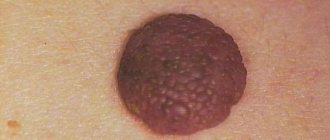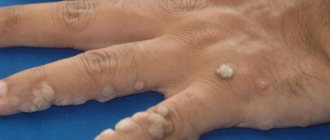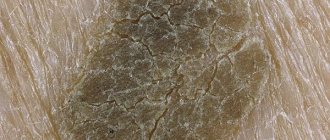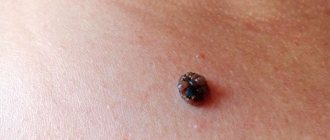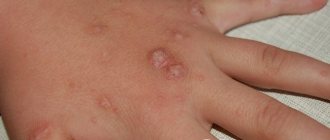Papillomas on the neck are skin growths of a viral nature, a symptom of papillomavirus. It is invisibly present in the body of 90% of people on the planet. Among the carriers are small children, newborns, the elderly, young people, and pregnant women. The infection enters the body unnoticed and waits for years for the right moment to attack. Activity is indicated by growth and an increase in the number of neoplasms.
General information
Papillomas are formations on the skin that appear as a result of the proliferation of epithelial cells. Their appearance is associated with the human papillomavirus (HPV).
This is a very common virus. Statistics show that about 70% of people in the world are infected with it, and 90% of the planet's inhabitants are carriers of HPV. At the same time, characteristic growths - papillomas - are not found in all people. It is important to consider that some strains of the virus may have oncogenic properties and lead to tissue transformation into malignant tumors. But in most cases, these are benign formations that look like a soft growth on the skin that is brown or flesh-colored.
Such formations can appear in different places - both on the skin and on the mucous membranes. Quite often they appear on the neck. What factors provoke their appearance and how to get rid of such formations will be discussed in this article.
Pharmacy drugs without a doctor's prescription
For you, we have prepared an excerpt from the most popular pharmaceutical drugs for the treatment of HPV.
Papinol
A complex preparation based on herbal components, which allows not only to get rid of cosmetic skin defects, but also has a strengthening effect on the immune system, preventing infection with papillomavirus:
- Dilute 1 capsule in 100 ml of clean water and take once a day 30–40 minutes before meals;
- simultaneously with oral administration, treat the affected skin with ointment 2-3 times a day.
lapis pencil
The drug is in the form of a hard pencil with a rounded top, grayish-white or white, containing silver nitrate. Apply the product directly to the location of the papilloma 1-2 times a day until the growths disappear.
Super clean
Contrary to the name, the solution does not contain plant components and consists of sodium hydroxide (alkali), soda and salt. The use of the drug can cause severe burns and requires strict adherence to the instructions:
- carefully treat the location of the growths with cream, including the papillomas themselves;
- make a slit in the adhesive plaster and glue it so that the hole coincides with the tumor;
- Apply a drop of the drug using a pipette, making sure that the liquid does not spread onto adjacent tissues;
- wait until the solution dries and remove the patch.
The course of treatment is 5 days, during which time the papilloma will turn black.
Pathogenesis
Papillomas develop from squamous or transitional epithelium. When a certain type of HPV infects a type of epithelium, characteristic changes in the skin occur. After infection has occurred, normal differentiation is observed in epidermal cells. In the cells of the spinous layer, clonal expansion, transformation and malignization of infected cells of the basal layer, which have undergone only primary differentiation, occur. When the cells of the stratum spinosum move into the stratum granulosum, they are very active in producing viral DNA. The assembly of mature viral particles occurs in the stratum corneum, followed by their release and budding on the surface of the epithelium or epidermis. Upon contact with these areas, infection occurs. Sometimes cellular immunity , blocking the persistence of the virus, leads to spontaneous regression of the lesions. However, contamination of neighboring areas may also occur. With HPV, cellular immunity is very often reduced and interferon .
How to stop bleeding
Every person should know what to do if a papilloma comes off and bleeding comes from it. At home, first of all, it is necessary to stop the bleeding and carry out antiseptic treatment. For these purposes, you can use what you have at home: a solution of potassium permanganate, fucorcin, hydrogen peroxide, ethyl alcohol. The most gentle remedy is hydrogen peroxide. It allows you to quickly stop bleeding and does not cause discomfort.
Processing sequence:
- A sufficiently large amount of antiseptic is applied to a cotton swab or cotton pad and the wound surface is thoroughly wiped with it. It is important to ensure that there are no cotton fibers left in the wound, which can cause secondary infection.
- To stop bleeding, apply a piece of sterile bandage folded in several layers to the wound.
- You need to hold the bandage for at least 5 minutes to ensure that the blood stops flowing. In this case, it is important to correctly regulate the force of pressure so that stopping the blood flowing from the wound does not disrupt local blood circulation.
- After the bleeding has completely stopped, it is necessary to re-treat the wound surface with an antiseptic agent, and then cover it with a bandage or plaster.
- The next smart step is to make an appointment with a dermatologist as soon as possible.
If there is such a possibility, then the torn piece of papilloma must be placed in saline solution and taken to a medical facility as soon as possible for diagnostic testing. If, after a papilloma has been torn off, the patient still does not want to go to the doctor or does not have such an opportunity, then it is important to at least initially observe the condition of the damaged area, and if suspicious signs are detected, go to a medical facility without delay.
Classification
There are several types of papillomas that can appear on the neck and other places:
- Thread-like - a yellowish formation, grows quickly, has a long stalk, and a ball at the end.
- Flat – protrude slightly above the skin, pink or brown.
- Simple or vulgar - large formations with dense irregular edges protrude several millimeters above the skin.
Most often, flat papillomas and warts appear in the neck area.
Taking into account the degree of oncogenicity, the following types of such formations are distinguished:
- Low degree - the risk of developing a malignant process is likely only in the presence of a hereditary predisposition.
- Moderate degree - a malignant process can develop if there is constant exposure to harmful factors, both external and internal.
- High degree - high probability of developing a malignant tumor.
Possible complications
If the papilloma falls off on its own, and no special measures were taken, then dangerous consequences develop:
- The formation of numerous neoplasms near the affected area, if the loss occurred after damage. This does not happen with strengthened immunity.
- Penetration of infection into the wound with the subsequent development of a severe inflammatory process.
- Risk of potential degeneration into an oncological tumor . This phenomenon occurs less frequently, unlike damage to a mole, but it is better to play it safe and get examined by a doctor.
Causes of papillomas on the neck
HPV infection can occur through sexual contact, in everyday life through contact with the skin or mucous membranes of an infected person, during childbirth - from mother to baby.
If a person is a carrier of HPV, very often the virus does not manifest itself in any way for a certain period of time. The reasons why small papillomas appear on the neck are associated with a weakened immune system, a deterioration of both local and general immunity.
Speaking about what causes small papillomas and why such formations grow, it should be taken into account that their formation can be influenced by the following factors:
- Hypothermia.
- Regular and severe stress.
- Excessive physical activity.
- Chronic fatigue.
- Hormonal disorders.
- Diseases of the gallbladder, kidneys, pancreas, pelvic organs.
- Infectious diseases.
- Avitaminosis.
- Autoimmune diseases.
- Promiscuous and unprotected sexual intercourse.
- Excessive exposure to ultraviolet radiation on the body.
Sometimes a person notices that small papillomas on the neck have appeared or become inflamed after prolonged use of certain medications, chemotherapy , or radiation therapy .
Speaking about why papillomas appear on the neck of women, it should be noted that such formations can appear during pregnancy , when active hormonal changes occur in the body and immunity . During the period of bearing a baby, small papillomas on the neck and in other places may increase, and their number may increase.
Prevention
It is impossible to completely protect yourself from HPV, since the virus can lie in wait anywhere. However, there are a number of recommendations that will help reduce the likelihood of infection:
- Avoid contact with a sick person and under no circumstances use their household items.
- Limit visits to saunas and swimming pools, where the likelihood of infection is extremely high.
- Have a regular sexual partner, use barrier contraception.
- Observe the rules of personal hygiene, do not give personal items and clothing to anyone.
- Strengthen your immune system through proper nutrition and an active lifestyle.
- Give up bad habits in favor of a healthy lifestyle.
If a person has a strong immune system, then after infection the body will be able to overcome the virus, preventing its accumulation and manifestation in the form of papillomas.
Symptoms
Such formations on the neck are generally soft or hard tumors that are pedunculated or broad-based. The size of such formations is 1-2 cm. The color can be either flesh-colored or brown. The outer surface is rough. Sometimes the papilloma grows in different directions and becomes like a cauliflower or cockscomb.
Depending on the type of virus, the symptoms may differ. In the neck area most often formed:
- Flat papillomas - look like bumps with a smooth surface. Their color is the same as healthy skin.
- Filiform papillomas are small yellow bumps that over time can transform into oblong-shaped compactions and reach up to 6 mm.
- Simple warts are formations that protrude 1-2 mm above the skin, may be slightly darker than the skin, and have uneven, dense edges.
When is medical help needed?
After treating a detached papilloma, you need to carefully listen to your own feelings. What to do next will depend on how you feel. If the next day after the incident there is pain, burning, the skin around the wound turns red and becomes hot, you should consult a dermatologist. Such symptoms indicate an inflammatory process.
Infection with papilloma poses a danger to the entire body. This small growth has good blood circulation. Inflammation of papilloma leads to the fact that the infection spreads through the bloodstream throughout the body. Treatment may require removal of the papilloma and further antiviral therapy or antibiotics for severe inflammation.
Papillomas can come off for various reasons, and this does not always pose a health hazard. However, there is a risk of tumor cells degenerating into cancer. The alarming symptoms in this case are as follows:
- pain and burning;
- itching;
- darkening of the growth;
- bleeding or dark discharge;
- increase in size.
Malignant papilloma can become covered with a crust, under which a weeping wound remains. However, such a wound does not heal, which is the first sign of a malignant process occurring in the skin cells. In this case, you should immediately consult a doctor.
The doctor will remove the papilloma and send the tissue for histological analysis. Once cancer is confirmed, further treatment will depend on how far it has spread. If a malignant process begins in healthy tissues around the papilloma, the patient is prescribed chemotherapy and skin irradiation.
Tests and diagnostics
If such formations appear on the neck, you need to visit a dermatologist. If necessary, he can advise which other doctor should be consulted. Initially, the specialist examines and interviews the patient, determining the characteristics of papillomas, the time of their appearance and the factors that could provoke it.
Additional laboratory and laboratory tests are also prescribed:
- General and biochemical laboratory blood tests.
- Carrying out a biopsy , for which material is removed.
- Polymerase chain reaction method (allows you to determine the presence and type of HPV).
Treatment with folk remedies
Folk remedies can be used as auxiliary methods during treatment. But before using them, you should definitely consult your doctor. The following traditional medicines can be used:
- Garlic ointment . It is necessary to grind the garlic and mix it with the same amount of Vaseline. Apply to papillomas every day. An ointment is prepared in the same way, replacing the garlic with young stems of celandine.
- Laundry soap . Since soap, when it gets on the skin, creates an alkaline environment, it is used to treat papillomas on the skin. Before going to bed, you need to rub them with laundry soap. This procedure must be carried out every day for a month.
- Celandine . Every day, the formations need to be treated with celandine juice, after which cotton wool soaked in the juice of the plant should be applied on top and sealed with a band-aid. This treatment should be carried out for a month or longer.
- Castor oil . Twice a day you need to rub castor oil into the places where formations have appeared.
Medical removal of formations
Read below about the most affordable ways to get rid of papilloma with the help of medications.
Acid-based preparations
- Salicylic ointment (60%) – the product contains salicylic acid and petroleum jelly. Use the drug in the form of spot applications on papillomas 2 times a day (morning and evening). The procedure may be accompanied by burning and redness of the skin. The product causes drying, dying and falling off of growths.
- Solcoderm is a solution based on nitric, acetic, oxalic and lactic acid. Treat the area where the growths are localized with ethyl alcohol, then apply the composition to the skin area using a plastic applicator. The total area of the treated surface should not exceed 3 cm2. Within a few days after the procedure, the skin acquires a brownish-yellow tint and mummifies. If such changes have not occurred, the processing can be repeated.
- Duofilm is a solution containing salicylic and lactic acid. Apply 1-2 drops of the product with an applicator 1-2 times a day to new growths and leave on the skin until completely dry. The maximum course of treatment is 7 days.
Phenol based
- Feresol - contains phenol and tricresol. Treat the growths continuously with the product for an hour. After the dried crust falls off, repeat the procedure after 6-8 days.
- Verrucacid is an oily preparation based on metacresol and phenol. Apply the product to the spots of the growths 3-4 times in one procedure, maintaining an interval for the previous layer of the product to dry. Re-application is possible a week after the crust falls off. A total of 5 treatments are allowed.
Diet
Diet to boost immunity
- Efficacy: therapeutic effect after 3 weeks
- Terms: 1-3 months or more
- Cost of products: 1600-1800 rubles. in Week
Nutrition should be complete and varied, since it is very important to compensate for the deficiency of vitamins and minerals in order to strengthen the patient’s immunity. The following products must be included in the menu:
- Peppers, citrus fruits, currants, rosehip decoction, sauerkraut - they contain a lot of vitamin C.
- Sea fish.
- Vegetable oils.
- Greens, fresh vegetables.
- Lean meats.
- Dairy products.
- Honey.
The following products should be excluded from the menu:
- Fried food.
- Sugar, sweets.
- Alcohol.
- Animal fats.
- Preservatives, smoked products.


